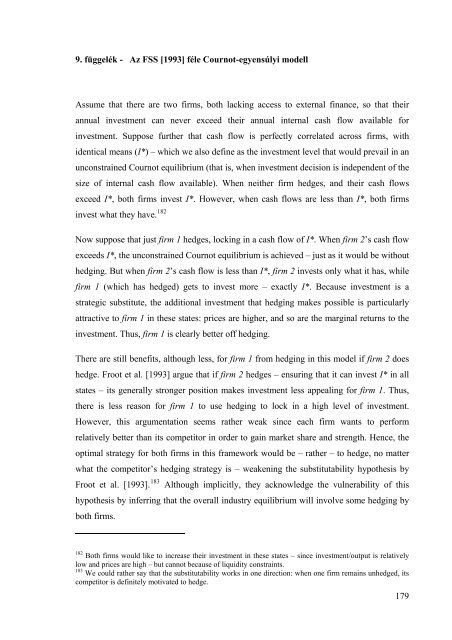értekezés - Budapesti Corvinus Egyetem
értekezés - Budapesti Corvinus Egyetem
értekezés - Budapesti Corvinus Egyetem
You also want an ePaper? Increase the reach of your titles
YUMPU automatically turns print PDFs into web optimized ePapers that Google loves.
9. függelék - Az FSS [1993] féle Cournot-egyensúlyi modell<br />
Assume that there are two firms, both lacking access to external finance, so that their<br />
annual investment can never exceed their annual internal cash flow available for<br />
investment. Suppose further that cash flow is perfectly correlated across firms, with<br />
identical means (I*) – which we also define as the investment level that would prevail in an<br />
unconstrained Cournot equilibrium (that is, when investment decision is independent of the<br />
size of internal cash flow available). When neither firm hedges, and their cash flows<br />
exceed I*, both firms invest I*. However, when cash flows are less than I*, both firms<br />
invest what they have. 182<br />
Now suppose that just firm 1 hedges, locking in a cash flow of I*. When firm 2’s cash flow<br />
exceeds I*, the unconstrained Cournot equilibrium is achieved – just as it would be without<br />
hedging. But when firm 2’s cash flow is less than I*, firm 2 invests only what it has, while<br />
firm 1 (which has hedged) gets to invest more – exactly I*. Because investment is a<br />
strategic substitute, the additional investment that hedging makes possible is particularly<br />
attractive to firm 1 in these states: prices are higher, and so are the marginal returns to the<br />
investment. Thus, firm 1 is clearly better off hedging.<br />
There are still benefits, although less, for firm 1 from hedging in this model if firm 2 does<br />
hedge. Froot et al. [1993] argue that if firm 2 hedges – ensuring that it can invest I* in all<br />
states – its generally stronger position makes investment less appealing for firm 1. Thus,<br />
there is less reason for firm 1 to use hedging to lock in a high level of investment.<br />
However, this argumentation seems rather weak since each firm wants to perform<br />
relatively better than its competitor in order to gain market share and strength. Hence, the<br />
optimal strategy for both firms in this framework would be – rather – to hedge, no matter<br />
what the competitor’s hedging strategy is – weakening the substitutability hypothesis by<br />
Froot et al. [1993]. 183 Although implicitly, they acknowledge the vulnerability of this<br />
hypothesis by inferring that the overall industry equilibrium will involve some hedging by<br />
both firms.<br />
182 Both firms would like to increase their investment in these states – since investment/output is relatively<br />
low and prices are high – but cannot because of liquidity constraints.<br />
183 We could rather say that the substitutability works in one direction: when one firm remains unhedged, its<br />
competitor is definitely motivated to hedge.<br />
179
















